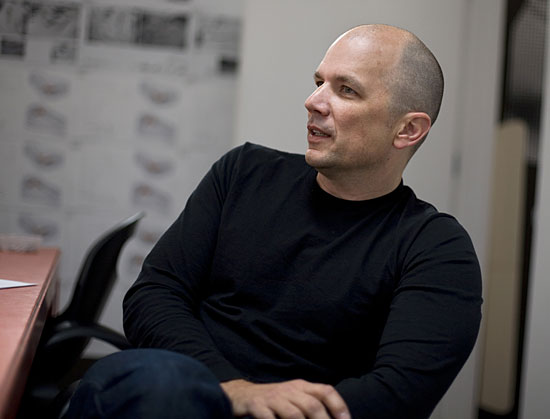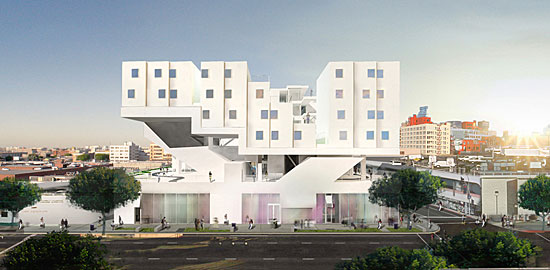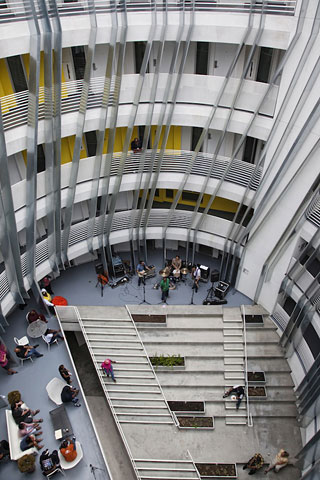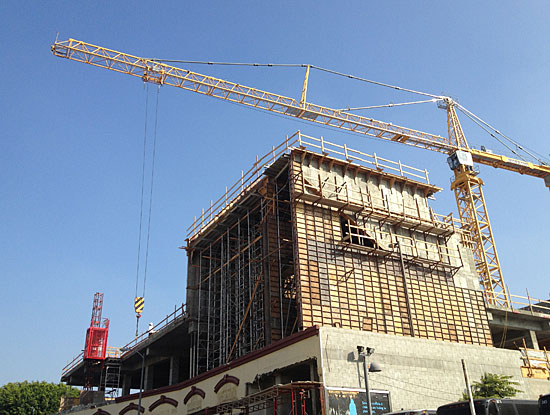Putting the fab in pre-fab on Skid Row
November 29, 2012
Architect Michael Maltzan builds museums and mansions. His latest commissions include an addition to the American ambassador’s residence in Paris, a new pier in St. Petersburg, Florida, and an arts center for Rice University. Architectural Digest hails his “visionary approach” and the New York Times has dubbed him “a darling of wealthy art world patrons.”
So what’s an acclaimed architect like Maltzan doing in a place like L.A.’s Skid Row?
You’d be amazed.
Maltzan, whose firm is based in Silver Lake, is helping to rewrite the playbook on designing housing for the homeless in Los Angeles. Over the past five years, his two projects for the non-profit Skid Row Housing Trust—the Rainbow Apartments and the New Carver Apartments, next to the 10 Freeway at Hope Street—have pushed the envelope of what it means to create shelter while fostering a healing sense of community.
Now he’s at it again, venturing for the first time into a project that will graft pre-fabricated housing units onto an existing, multi-use single-story building at 6th Street and Maple Avenue. A new “structural tray” atop the original building will support the network of 100-plus studio apartments being trucked in from a factory in Idaho, while also forming a kind of outdoor mezzanine with community gardens, jogging track, basketball court, yoga platform and shared kitchen, laundry and computer room spaces. Supportive services, including a ground-floor medical clinic, will serve not just the residents of the new Star Apartments, but also people who live in the surrounding community.
The first units won’t be installed until December and the building isn’t set to open until next spring or early summer, but already Maltzan’s design is being lauded for its “elegant composition of prefabricated blocks.”
The Star project represents “a big innovation,” says Mike Alvidrez, the Housing Trust’s executive director. He praises Maltzan for bringing “a very fresh, innovative way of thinking about buildings…in particular when it comes to how design can be influential in terms of helping people recover from homelessness.”
Creating social, communal interactions is a big part of the Star’s design. The homeless, Maltzan says, “live on the street all the time. We think that they must be very well adjusted to living in public, but the reality is, the only way a human being is able to survive in that kind of situation without any private life at all is to create that private life within themselves, and start to create a real shell around themselves and disconnect from culture and community around them.”
So unlike the old transient hotel experience, where “you felt like you were under surveillance” when you entered the lobby and then “disappeared into your room and were never seen until you came back out,” the Star is designed so residents will step onto a walkway or balcony when they leave their units.
“You are moving through a more social situation,” Maltzan says.
He’s also excited about his first foray into pre-fabrication. Using pre-fab methods to build multi-family housing is more economical, efficient and environmentally-friendly than traditional construction methods—and, contrary to old stereotypes, offers sturdier, easier-to-maintain living spaces, he says.
“It allows us to reach a higher level of quality for the same cost,” he says. “When I say higher level of quality, it’s not making it fancier. It’s making it better, more durable, and nicer to use when you’re in the unit.”
And looks matter—whether you’re building a 28,000-square-foot residence for a mogul like Michael Ovitz or a 340-square-foot refuge for someone used to sleeping on the street.
“A big part of our goal,” Maltzan says, “is to say that architecture and design and beauty are something that should be accessible to the full range of the population of Los Angeles County.”
Not everybody saw it that way, at least initially. After the opening of his first Skid Row Housing Trust project, the Rainbow, some people asked him:
“Why are you making these buildings look so good? Why are you making them so identifiable? That must be more expensive. Why aren’t you just housing these people?”
Maltzan disagrees—not just on the expense question but on the notion that good design is just for the privileged. And he’s heard the same thing from people who live in his buildings, including the Rainbow.
“I’ve been to that building many, many, many times. I’ve been there when people knew I was the architect and I’ve been there when people didn’t know I was the architect. And the thing I get again and again and again from that community is, ‘We live in a place that looks like something, as opposed to a place that looks like nothing.’ ”
The new approach to building for the homeless is part of an overall shift that emphasizes the value of creating “permanent supportive housing,” which provides not just a roof overhead but surrounds residents with vitally-needed medical, mental health and other services. Project 50, which targeted some of the most entrenched residents on Skid Row for such housing, is a widely-cited success story, praised for transforming lives and saving money.
The Star Apartments, the first pre-fab homeless housing complex in L.A., is expected to embody those principles—and perhaps provide a template for the future.
“I think we could use many, many more projects like this,” says Alvidrez, of the Skid Row Housing Trust.
For his part, Maltzan thinks important elements in the Star Apartments could work all over Los Angeles—and not just for a homeless clientele.
“I can’t wait to do another project like that,” he says.
Maltzan, 53, who grew up in Levittown, N.Y. and was educated at the Rhode Island School of Design and at Harvard, moved to Los Angeles in 1988. He and his wife, Amy Murphy, an architecture professor at USC now pursuing a PhD in the university’s School of Cinematic Arts, now live with their two children in Pasadena.
He considers L.A. “the most compelling laboratory for thinking about the future of cities and the future of architecture in relationship to those cities.”
And he thinks he sees a glimpse of the future in the homeless housing efforts now afoot.
“As a citizen in the community, it makes me feel optimistic that you can effect change in a positive way in what most people have said is an intractable dynamic, that homelessness just can’t be changed, that that community is lost,” he says. “That is not the case. You can effect real change.”
There’s also a sense of vindication for his profession as a whole.
“One of architecture’s responsibilities is to use its capacity to continue to move cities and communities forward. And that includes making very pragmatic and functional buildings, cost-effective buildings, but also buildings that look like something, that stand for something, that aren’t shy in creating iconic structures that are for the culture as a whole,” he says.
“It’s extremely important for us to make the very best for the wealthiest segments of our community as well as for the less privileged in our communities. And it’s only when we work in all of those segments that you have any hope of creating a viable, sustainable, progressive metropolis.”
Posted 11/29/12
















 405 bridge work causes a stink
405 bridge work causes a stink

